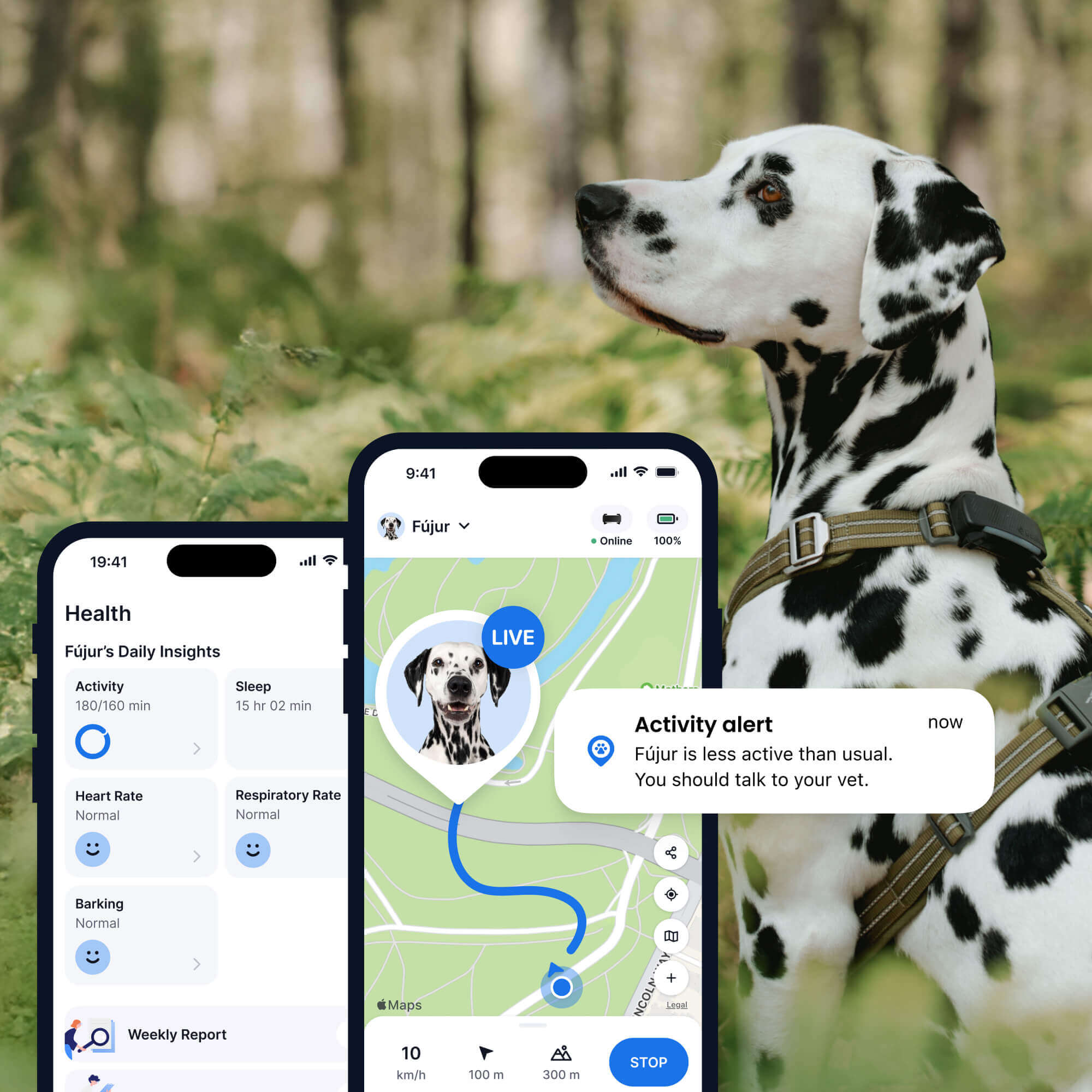Why Your Dog Doesn’t Want To Walk & What You Can Do
If your dog refuses to walk, it's usually a sign of something more serious. Here's what's underlying it & what steps you can take.

You’re standing there with a leash in your hand, and your furry friend is a stubborn lump on the pavement. We’ve all been there! But if your dog doesn’t want to walk out of the blue, it isn’t just them being “stubborn.” More often than not, it’s a sign that something else is going on. Here’s a guide to help you get to the bottom of things and how a smart dog tracker with Activity Tracking can help.
Key Takeaways
If a dog doesn’t want to walk, it could be a sign of an underlying issue, not just stubbornness. The root cause is often medical, behavioral, or environmental.
You can encourage your dog to walk again through patience, positive reinforcement, and by making adjustments to their training and walking environment.
A sudden drop in your dog’s activity level can be a serious red flag for their health, and it’s important to monitor for other physical symptoms.
Smart dog trackers like Tractive can help you monitor your dog’s daily activity, spot unusual changes with Health Alerts, and even keep you both motivated to stay active.

Always know your buddy is healthy & safe
Read moreMy dog refuses to walk – what gives?
If your dog doesn’t want to walk out of nowhere, lies down mid-walk, or just refuses to move, it’s a clear signal. The key is to figure out what they’re trying to tell you. It could be because of:
Medical conditions
Dogs are incredibly good at hiding pain, so what looks like stubbornness could be a cry for help. Your dog might have a sprained paw, a cut on a paw pad, or a thorn stuck in their fur. Check their paws and legs carefully. An underlying medical issue like arthritis, hip dysplasia, or even a systemic infection can make walking uncomfortable or painful. If the behavior is sudden and persistent, especially in an older dog, a vet visit is the most important first step.
Some dogs, especially puppies, seniors, or dogs who are out of shape, can also get tired easily. If you’ve been on a long walk or it’s a particularly hot day, your dog might just be telling you it’s time to rest.
💡A smart dog tracker with Health Monitoring can help you pick up on a drop in your dog’s activity quicker. (Usually one of the first signs their health isn’t doing so well.)

Get health alerts for your dog
Our pups can’t always tell us if something’s wrong. But if their tracker detects unusual changes in their routine, you’ll get an alert, helping you catch potential issues early.
Behavioral issues
If you’ve ruled out physical problems, the reason for the refusal might be behavioral. Fear and anxiety are common causes when a dog doesn’t want to walk. (Particularly for rescue dogs or puppies in their socialization period.) Your dog might be afraid of something in the environment – a loud truck, a barking dog, a specific person, or even a strange-looking mailbox. They may freeze and refuse to move as a self-protective measure.
Another reason could be your dog simply needing leash training. For puppies and young dogs, the leash and harness itself can be a source of stress. They may not have a positive association with it yet, or they might feel restricted and panicked.
Finally, keep in mind that some dogs, especially certain breeds, are just naturally headstrong. They may have learned that if they lie down, they get to go home or get a treat. They might also be protesting the end of the walk, hoping to extend their time outside.
Environmental factors
The world outside can be overwhelming, and sometimes your dog just isn’t a fan of the conditions. Dogs can be sensitive to hot and cold temperatures. Hot pavement can burn their paw pads, while freezing temperatures and snow can be painful. Rain and strong winds can also be very uncomfortable. New sights, sounds, and smells on a new route can be too much for some dogs. A busy city street might be too stimulating for a dog used to quiet country paths.
Tips on how to get your dog to want to walk again
Once you have an idea of the “why,” you can start working on the “how.” The goal is to build a positive association with walking.
- Make walks a positive experience
Use some healthy treats and praise to reward your dog for every single step they take. Don’t reward them for lying down, but as soon as they get up and move, give them a treat and a ton of pats and praise. - Switch up your environment
If your dog is afraid of a specific street, take a different route. Start with short, quiet walks in familiar areas, like your backyard or a calm park. Gradually introduce new environments as they build confidence. - Give your dog some company
Walking dogs in a group (like with a friend or a local group) might encourage yours to keep up the pace if all the other dogs are walking. - Don’t skip out on leash training
Use a comfortable harness that doesn’t put pressure on their neck. Practice loose-leash walking in a distraction-free environment. A simple technique is to stop walking every time they pull, and only continue when the leash is slack again. This teaches them that pulling gets them nowhere. - Do your best to stay patient and calm
Your dog can sense your frustration. If they lie down, don’t pull on the leash. Instead, try kneeling down and calling their name in a happy tone, luring them with a treat. - Use the right gear
Ensure their collar or harness is comfortable and fits properly. Dog boots can be a lifesaver in extreme weather or on rough terrain. - “Trick” your dog
By pretending you’ve seen something exciting in the distance – and start walking or jogging towards it. This might motivate your dog to follow you.
Where a dog not walking can be a red flag
Sometimes, a dog refusing to walk isn’t just about a bad mood or stubbornness. It can be a serious sign that something is wrong. A sudden and significant drop in a dog’s activity level is often the very first sign of an underlying illness, injury, or pain. This is why many vets recommend keeping track of a dog’s everyday activity to establish a baseline for what’s normal for them.
“Keep track of your dog’s energy levels, especially how long they are able to walk. If you notice significant declines, it could be a sign of pain, heart disease, or other illness.“
Besides refusing to walk, look out for other signals that could be red flags for your dog’s health:
- Changes in gait
Limping, a stiff walk, or an unusual posture. - Vocalization
Whimpering, yelping, or crying when they try to move or stand up. - Lethargy
Being unusually tired, sleeping more than normal, or showing a general lack of energy. - Changes in appetite or thirst
Eating or drinking significantly more or less than usual. - Unusual breathing
Heavy panting, labored breathing, or a change in their breathing rate when at rest. - Physical signs
Swelling in joints, a visible injury, or sensitivity when you touch certain parts of their body.
If you notice your dog displaying these signs in addition to refusing to walk, it’s best to consult with your vet as soon as possible.
How a smart dog tracker can monitor their health & well-being
A smart dog tracker like Tractive isn’t just for finding a lost dog. It’s a powerful tool for understanding your dog’s activity and keeping you both on track. Strapped to your dog’s collar, you can now:
- Catch a drop in activity early
With its built-in motion detector, your trusty Tractive device keeps track of your dog’s everyday active minutes. This helps you establish a baseline for your dog’s everyday activity. By tracking their active minutes, rest periods, and sleep patterns, you can catch on to a significant drop in activity earlier, which is often the first sign that they aren’t feeling well. - Spot potential health issues early
Your tracker can send you Health Alerts if there are unusual changes in your dog’s sleep or activity. This serves as an early warning system for potential health issues.
Our dog started “slowing down” and wanting to head home earlier on walks. That ended up being the first sign of aggressive renal carcinoma invading her vena cava.
– Savingskitty (Source: Reddit)
- Monitor your dog’s vital signs
Tractive trackers can also monitor your dog’s resting heart rate and respiratory rate. These vital signs can help you spot potential issues related to stress, illness, or pain even before other symptoms appear. - Get a little healthy competition
For a little extra motivation, the community leaderboards allow you to see how your dog’s activity compares to other dogs in your area or of the same breed. This friendly competition can be a fun way to push yourself and your furry friend to get out and about more often.
Ultimately, if a dog doesn’t want to walk, they’re (usually) communicating something important to you.
By taking the time to observe their behavior, rule out medical issues, and using the right training techniques and tools, you can get back to enjoying your time together. The best thing you can do for your dog is to listen to them and respond with patience, understanding, and love.
And if you’ve liked this post, share it with a friend or a loved one – and let’s help build a safer, kinder world for our furry friends together.




